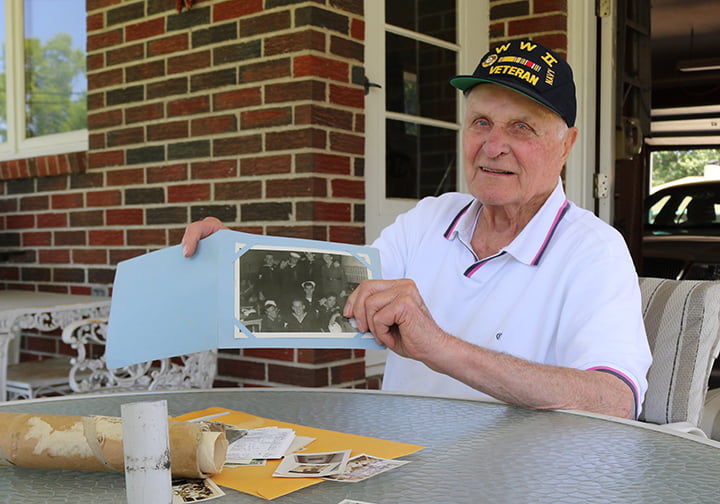
by Marc and Julie Anderson
mjanderson@theleaven.org
TOPEKA — Relief.
That’s how Maurice Dultmeier, a member of Christ the King Parish in Topeka, described the feeling aboard the U.S.S. Rockwall as it sailed under the Golden Gate Bridge in San Francisco at the end of World War II.
Just five years earlier, the 14-year-old Dultmeier was living in Seneca, a town of approximately 2,000 residents.
As the oldest of 13, Dultmeier helped out in the family hardware store, attended school and played a few sports. He faithfully attended Mass every Sunday, often serving as an altar boy.
Meanwhile, Americans were following the news of Germany’s military forces marching through Europe, as well as Japan’s aggressive military tactics throughout East Asia. Many believed it was only a matter of time before the United States entered the war.
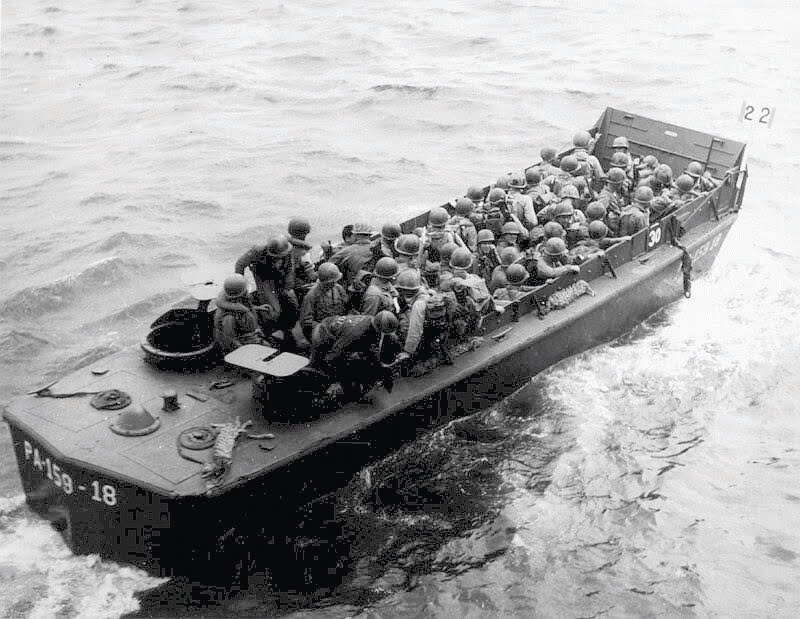
On Sept. 6, 1940, Congress passed the Selective Service and Training Act. It required all men between the ages of 21 and 35 to register with local draft boards, just in case their services would be needed in the military.
On Dec. 7, 1941, after the attack on Pearl Harbor, the “just-in-case” became a foregone conclusion. The next day, America entered the war.
Setting sail for the Pacific Theater
In late 1942, the federal government lowered the draft age to 18. So, after turning 18 in 1944, Dultmeier registered for the draft, ultimately leaving Seneca first for Omaha, Nebraska, to be sworn into the Navy, then to Farragut, Idaho, for boot camp.
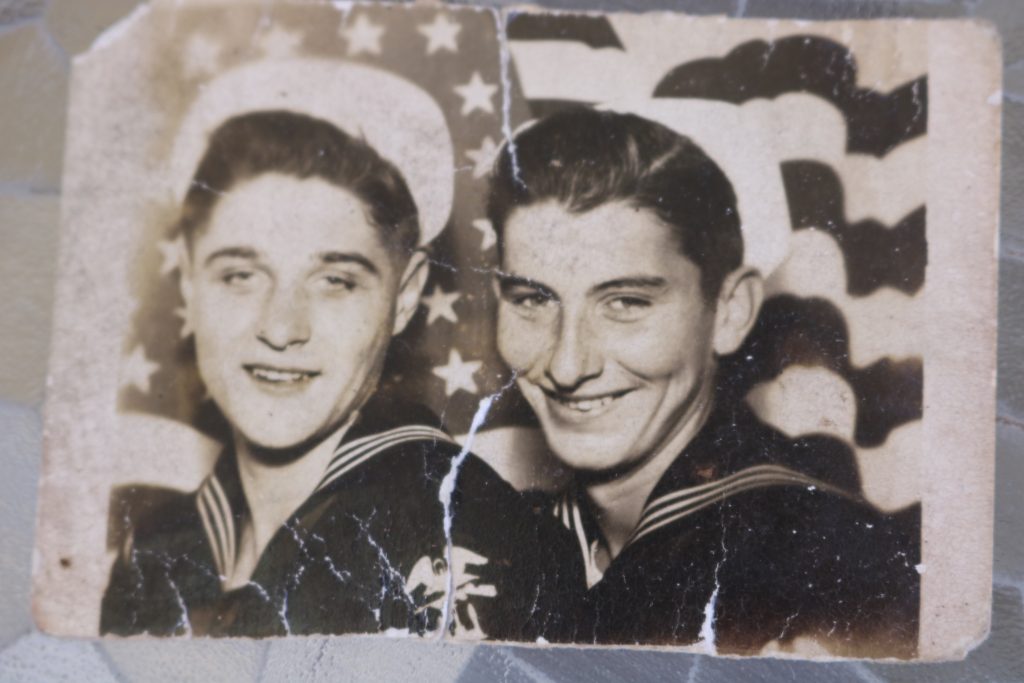
His final stop was California for naval school, after which he was assigned to the U.S.S. Rockwall.
“I enlisted in the Navy; I didn’t want to go into the Army,” said Dultmeier. “I didn’t want to be in a foxhole, and I thought life might be better on a ship.”
An amphibious landing ship, the Rockwall could hold up to 16 boats known as Higgins boats. Designed to land on beaches after being deployed from ships farther out from the coastline, a Higgins boat could hold up to 36 men or 8,000 pounds of cargo.
Smithsonian Magazine has called it “the invention that won World War II” because it gave the Allies the advantage in amphibious assaults.
“When we would invade islands, the Marines would get in the boats and hit the beaches,” Dultmeier said.
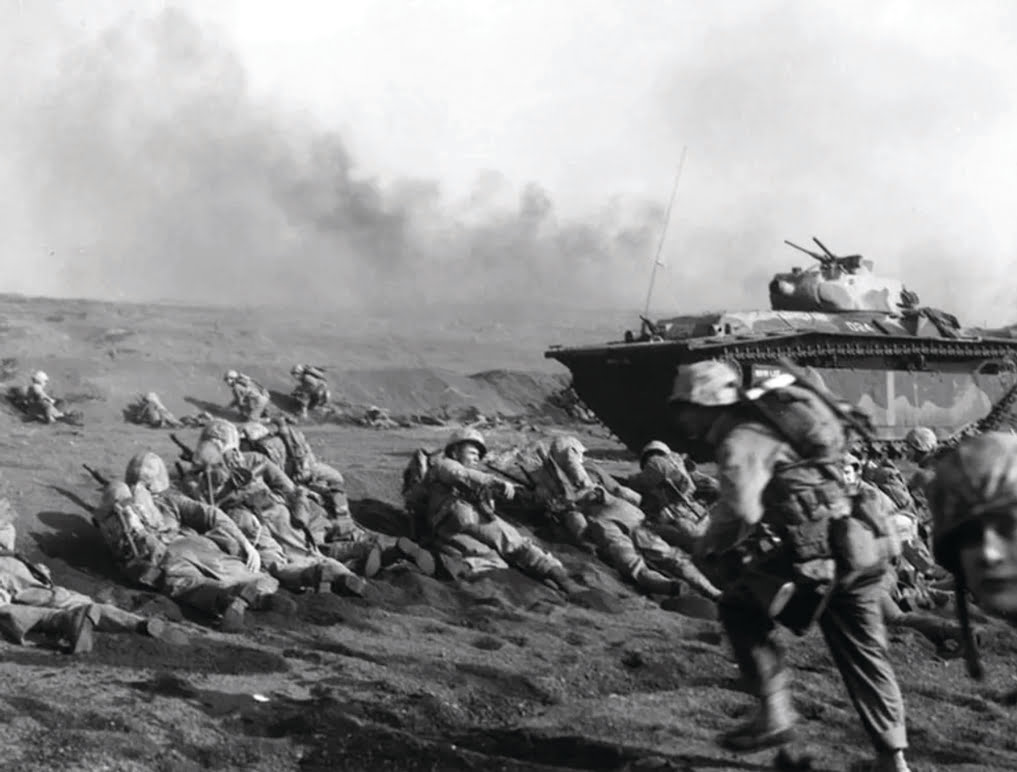
As a signalman, Dultmeier was never deployed in such a boat, but instead was involved in all ship communications.
“Signalmen on a ship had three ways of communicating. We didn’t have cellphones. We had the flag bag, semaphore and the signal light,” Dultmeier recalled. “Ninety-nine percent of the time, we signaled with the signal light, and we communicated back and forth between ships that way.
“After I got to be a signalman, I realized I was really lucky because I was in a good part of the ship. We were way up on deck — the flying bridge they called it. I didn’t have to chip paint or paint like all the seamen did. We had classes during the day sometimes.”
In addition to Morse code, he also learned to communicate through the various flags.
“They hoist them up, and they mean different things,” he said, adding, “the semaphore wasn’t used as much, but we could use the signal light and send signals 30 miles away. It was slow, but I did it.”
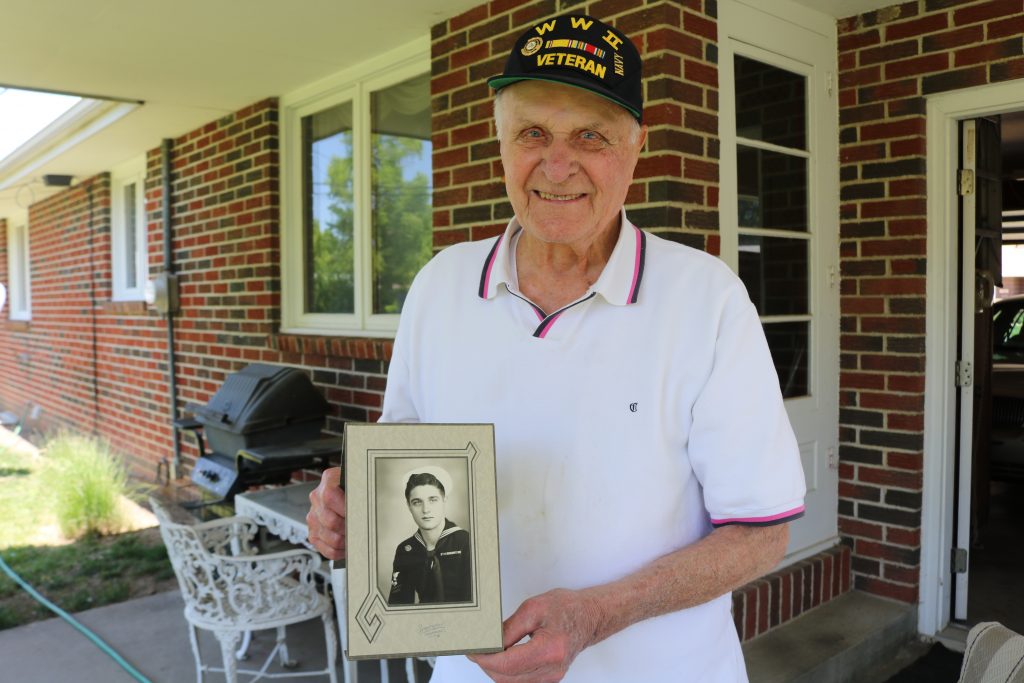
He’s not sure why the Navy selected him as a signalman, but his excellent eyesight might have had something to do with it.
“When I went in the Navy,” he continued, “the doctor said, ‘You have the best eyes I’ve ever seen.’
“Of course, a signalman needs good eyes to read the signals.”
Even now, at 94, Dultmeier does not wear glasses — has never worn them, in fact, not even for reading.
The battles of Iwo Jima and Okinawa
In 1945, the Rockwall transported Marines to Iwo Jima, after the initial invasion in February. Dultmeier remembers well the morning prior to the Marines’ departure.
“Everyone got up at 3 or 4 in the morning,” he said, “and the chaplain got on the loudspeaker and said a few prayers.”
Afterward, the ship grew eerily quiet.
“The guys that went ashore were very nervous,” Dultmeier said. “They didn’t know if they were coming back or not.”
“We unloaded the Marines,” he continued, “and they went in the Higgins boats and hit the beaches. It was a bloody battle. We had battleship after battleship pounding the shores with big guns.”

The battle raged for about a month, and more than 6,800 American servicemen were killed with another 9,000 wounded. Dultmeier said the Japanese refused to give up. According to military records, of the 20,000 men who made up the Japanese garrison, only a few hundred remained alive to be taken prisoner.
After Iwo Jima was Okinawa. Meant to be the final island battle prior to the United States’ planned invasion of the Japanese mainland, the battle began in late spring of 1945 and lasted nearly three months. Once again, Dultmeier aided in communications. According to military records, nearly 252,000 were killed, the vast majority of whom were Japanese military and Okinawa civilians.
From his vantage point, Dultmeier said, Iwo Jima was far worse at the time. History would prove the loss of life on Okinawa greater; however, most of the Battle of Iwo Jima was fought on the beaches, whereas the Battle of Okinawa was fought further inland. As a result, he didn’t see as much of it.
“The Navy didn’t go inland, you know,” he said.
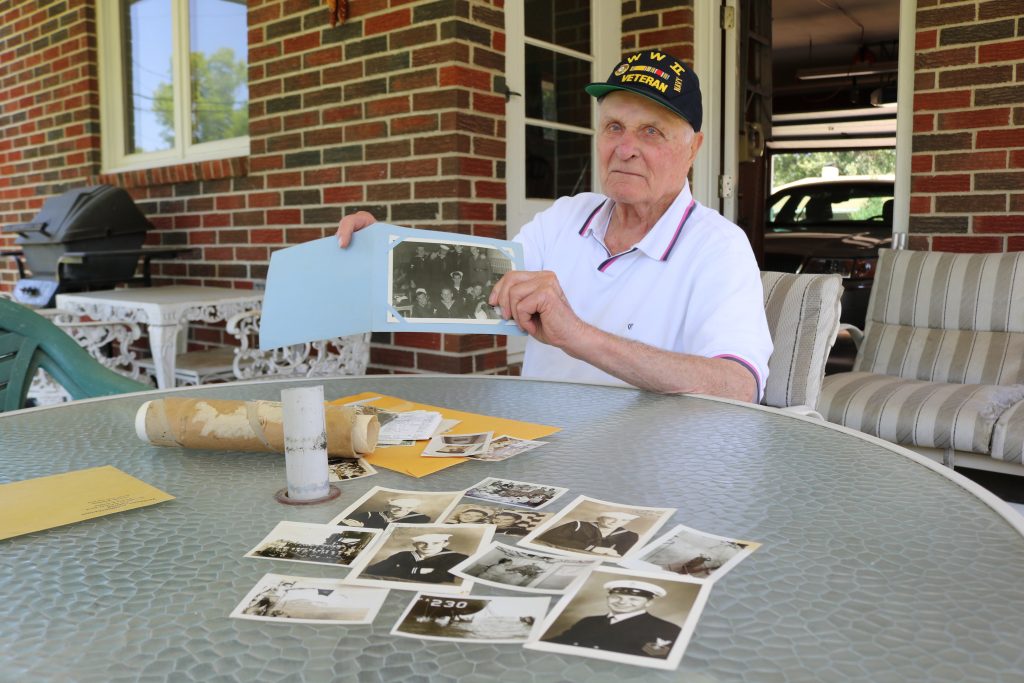
At Okinawa, however, the U.S. military had to contend with Japanese suicide attacks.
“That was Japan’s last desperate battle,” Dultmeier said.
After Okinawa, the Rockwall sailed to Aomori, Japan, as part of a sustained campaign to force Japan to surrender.
“We were bombing the heck out of Japan,” he said. “We would see masses of B-29s overhead, and a lot of them would be shot up coming back.”
Ultimately, the atomic bombs dropped on Hiroshima and Nagasaki in August 1945 convinced Emperor Hirohito to announce Japan’s surrender on Aug. 15.
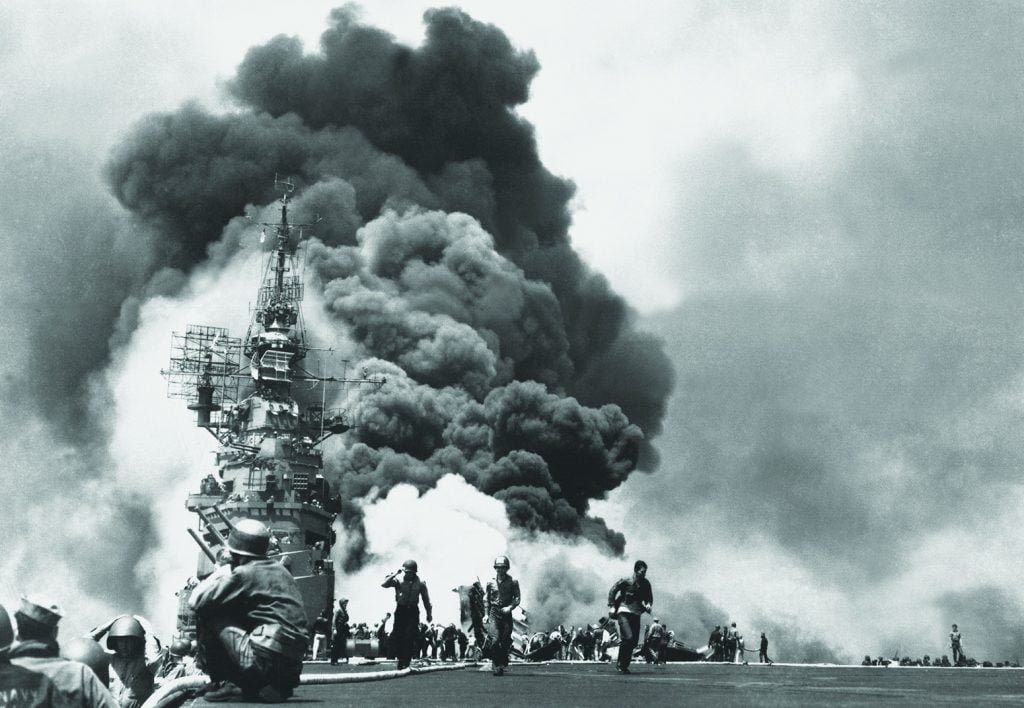
planes within 30 seconds during the Battle of Okinawa.
“The Japanese weren’t ready to give up,” acknowledged Dultmeier. “But those bombs were so destructive, I guess the leaders saw the handwriting on the wall.”
(The decision to drop the bombs has been controversial almost since the time it was made. While 75th anniversary events planned for Hiroshima and Nagasaki this year were to shine a spotlight on the devastating costs of that decision, most were either canceled or postponed due to the pandemic.)
Celebrating the end of the war
Dultmeier and his shipmates were witnesses not only to the end of hostilities, but also to the surrender of Japanese troops at different locations.
But at long last, he and his shipmates set sail for San Francisco.
“I might say, coming back to the United States, going under the Golden Gate Bridge, was the best feeling I ever had,” he said.
And the young sailors took full advantage of being home.
“That’s where we partied,” he recalled.
Still, as a signalman, he had his duties.
“We were pretty busy. We tied up at Oakland, and they had a band out,” said Dultmeier. “There were a bunch of Army guys on the ship, and their families were on the dock.
“I was up there, and the captain said to me, ‘Seaman Dultmeier, what do you think of that celebration?’ I said, ‘Very inspiring.’ They (the Army guys) were hugging and kissing their girlfriends and wives. It was quite impressive.”
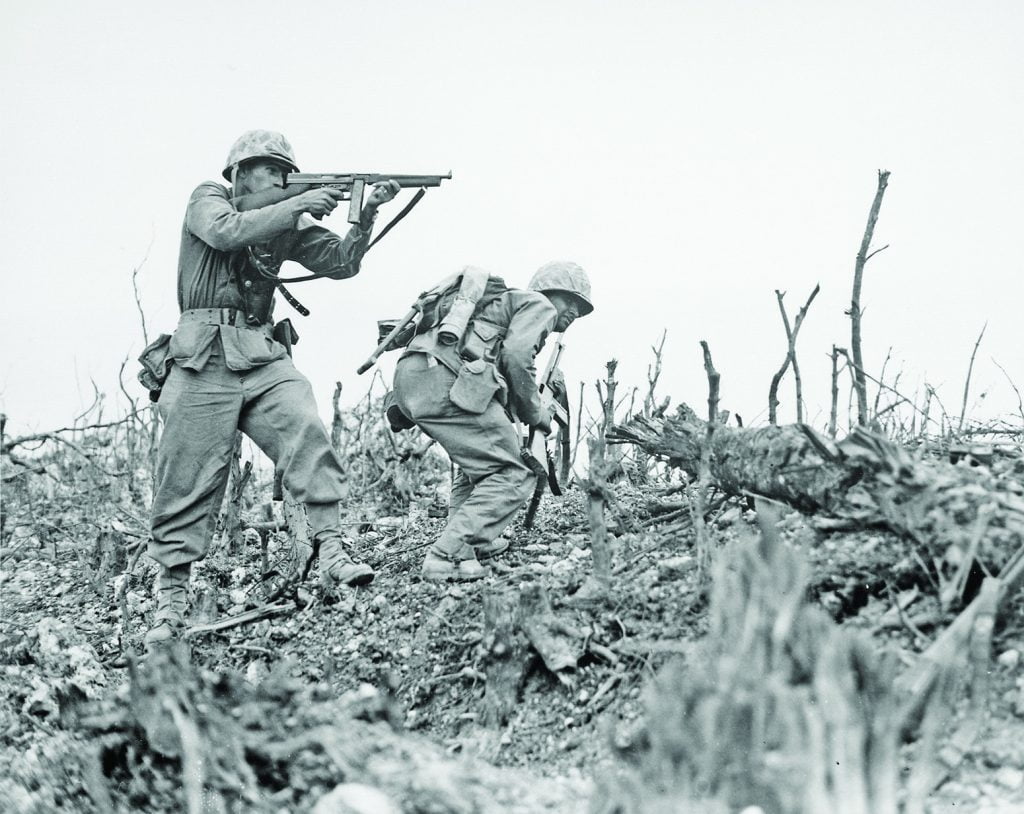
When Dultmeier thinks back on the war now — 75 years hence — it gives him pause.
“It united the country at that time. The whole country was united,” he said. “You could tell that. We had gas rationing, we had food rationing, but nobody complained.
“We’re not united [now] like we were. It takes something real serious to make the country unite and all feel the same way. Back then, we were all on the same page.”
Dultmeier said military service served him well, only strengthening the sense of discipline and teamwork he’d learned growing up in a large family and having been educated by the Benedictine priests and nuns of Sts. Peter and Paul Parish.
But when asked whether he believes his to be “the greatest generation,” Dultmeier merely shrugs.
“That’s what they say. We just did what we had to do,” he said. “None of us wanted to be out there. We all wanted to go home.
“That’s why we were so happy when it was over.”







Morris, I believe that the good looking gentlemen next to you in the photo is my father.
Good to see Maurice still alive and kicking. I rented a place from him in the early 2000s. I never knew this story about him so it’s an interesting read.
Thank you, Chuck and Marcia, for your kind note.
Great article! Loved the sentiment and honesty of his comments at the end. Thanks you for your service Maurice.